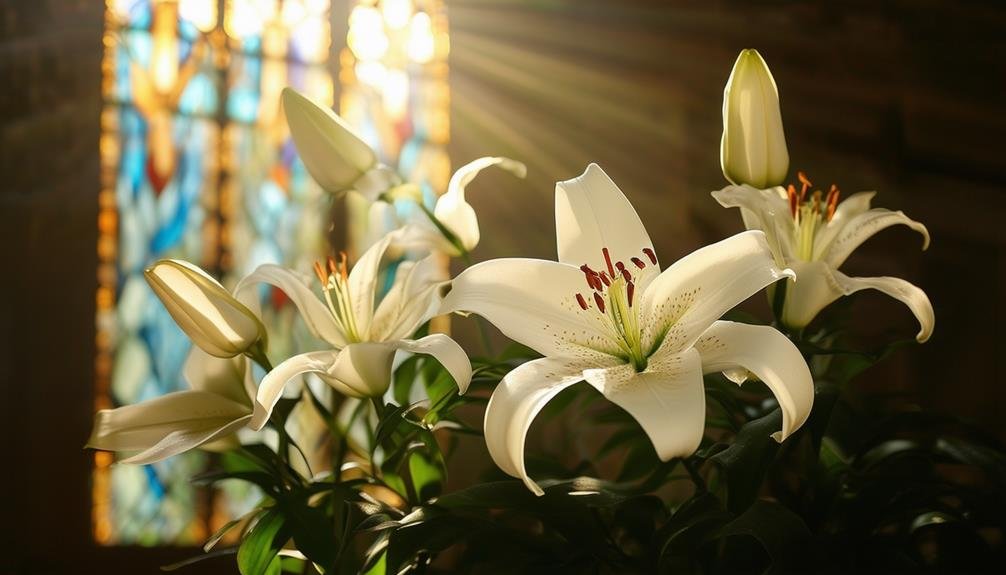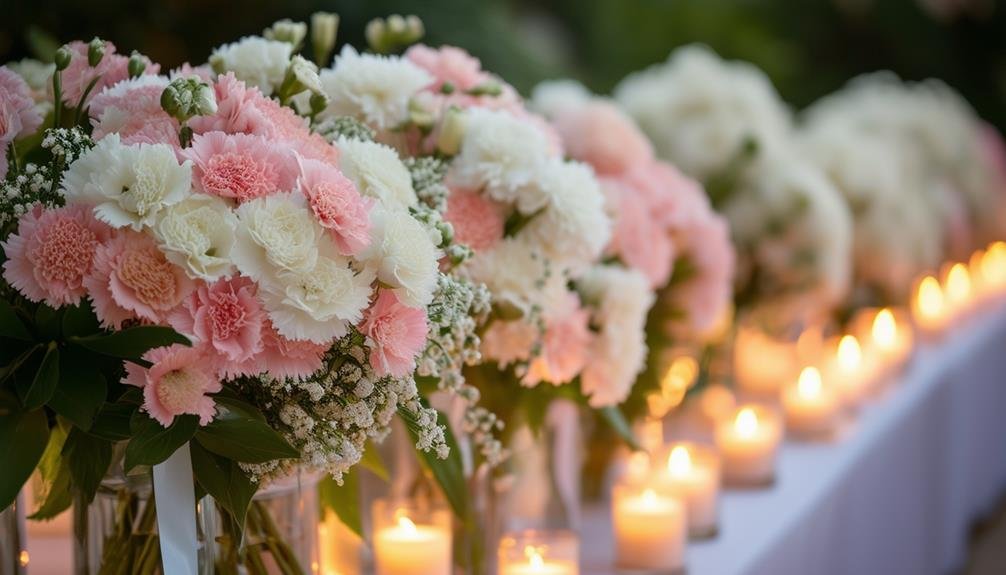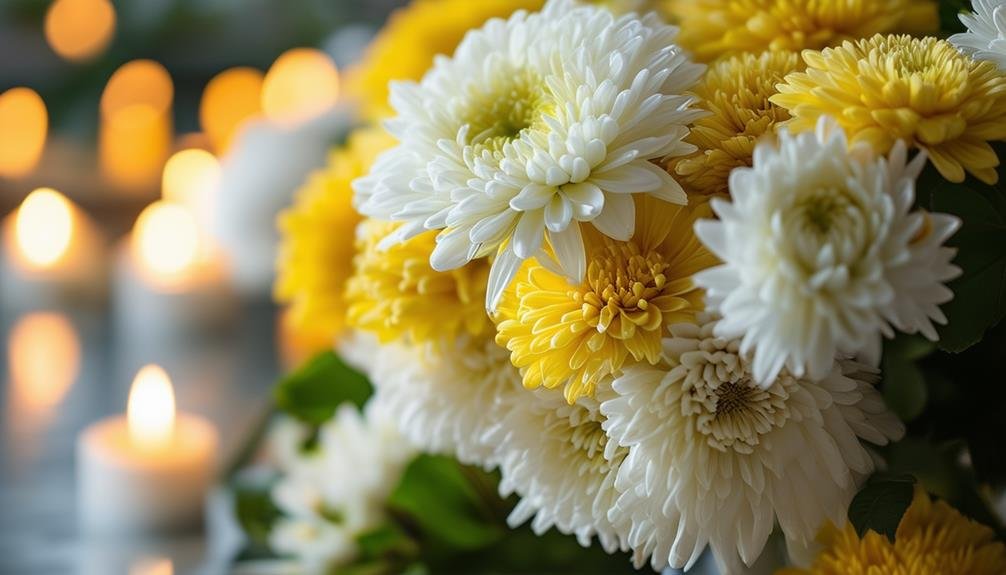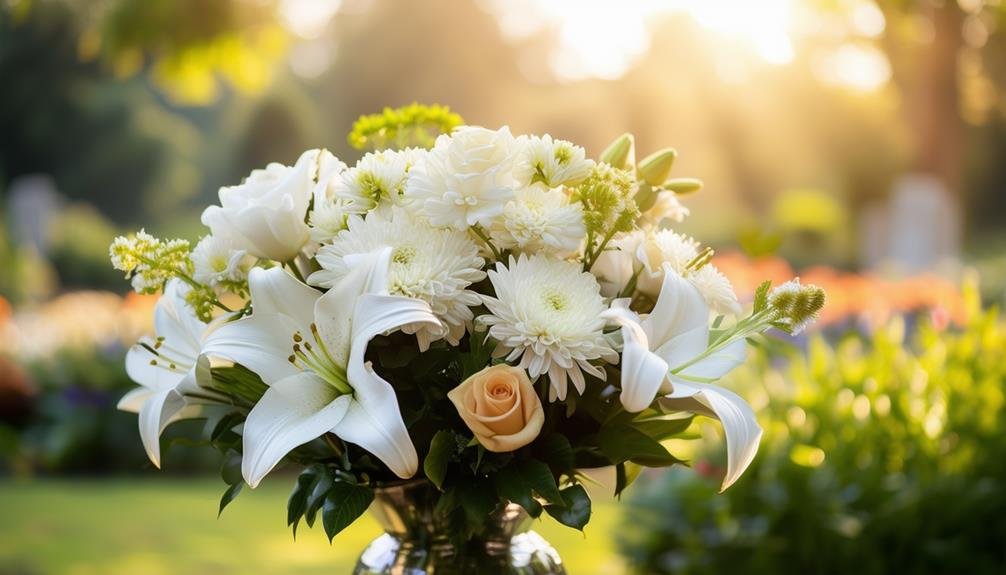Flowers like lilies, roses, carnations, orchids, and chrysanthemums are common at memorial services due to their profound
symbolic meanings. Lilies represent purity and peace, while roses convey
deep emotional resonance with different colours signifying sentiments such as love and respect. Carnations symbolise love and remembrance, and orchids denote beauty and strength, reflecting the
enduring legacy of the deceased. Chrysanthemums are valued for their
representation of respect and a life well-lived, especially in European and Asian traditions. With varied symbolism and
aesthetic appeal, these flowers provide a dignified tribute to honour loved ones. There is much more to uncover about their unique roles and meanings.
Main Points
- These flowers symbolise purity, love, respect, and remembrance, aligning with the sentiments expressed at memorial services.
- Their diverse colours allow for personalised tributes reflecting the unique relationships and qualities of the deceased.
- Cultural and religious significance makes these flowers appropriate for memorial traditions.
- Their aesthetic appeal adds serene beauty and a sense of peace to solemn occasions.
- Hardy and low-maintenance, these flowers ensure lasting tributes throughout memorial events.
Lilies
Lilies are a quintessential choice for
memorial services due to their
elegant appearance and
symbolic representation of
purity and the
restored innocence of the soul. This flower, particularly the white lily, is frequently associated with the themes of
renewal and peace, making it an
apt selection for commemorating the deceased. The symbolism of
lilies extends beyond their visual appeal; they hold a prominent place in various
cultural and religious contexts, most prominently within
Christian traditions.
One of the most significant aspects of lilies in memorial services is their association with
Easter symbolism. In Christianity, lilies are often linked to the resurrection of Jesus Christ, which is celebrated during Easter. This association imbues lilies with a sense of
hope and rebirth, aligning seamlessly with the sentiments typically expressed during a memorial service. The Easter lily, in particular, is emblematic of the resurrection and the promise of eternal life, providing comfort to those mourning the loss of a loved one.
Moreover, the purity representation of lilies further enhances their appropriateness for memorial services. The pristine white petals of the lily are often interpreted as symbols of purity, virtue, and the restored innocence of the soul in death. This makes them a meaningful tribute to the deceased, emphasising the purity and sanctity of the individual’s life and spirit.
In addition to their rich symbolism, lilies are also favoured for their aesthetic qualities. Their graceful, trumpet-shaped blooms and delicate fragrances contribute to creating a serene and contemplative atmosphere, which is fitting for memorial gatherings. This combination of symbolic depth and visual elegance ensures that lilies remain a preferred choice for honouring the departed.
Roses
While
lilies symbolise purity and renewal,
roses are celebrated for their deep
emotional resonance and versatility in memorial services. The rose has a rich history of symbolism across various cultures and epochs, often representing love,
respect, and honour. This
profound rose symbolism makes it a fitting choice for memorial services, where it conveys a
range of sentiments from sorrow and mourning to admiration and remembrance.
Roses are particularly versatile due to the
variety of rose colours, each bearing its unique connotation. Red roses are perhaps the most iconic, symbolising deep love and respect. Their presence at a memorial can reflect the profound affection and admiration felt for the departed. White roses, similar to lilies, denote purity and innocence, often suggesting the
peaceful return of the soul to a state of grace. They can also signify reverence and humility, making them appropriate for honouring the life of a loved one.
Yellow roses, although less common, can symbolise
strong ties of friendship and joy. While they might seem unconventional for sombre occasions, they are sometimes chosen to celebrate the
positive and joyful impact the deceased had on the lives of others. Pink roses, embodying grace and gratitude, are often used to express appreciation for the departed’s kindness and elegance.
Incorporating roses into memorial services allows for a
personalised touch, as their diverse colours and rich symbolism can be tailored to reflect the unique qualities and relationships shared with the deceased. This versatility and depth make roses a cherished element in floral arrangements that honour and remember loved ones.
Carnations
Carnations, with their rich history and varied hues, hold a special place in memorial services due to their
symbolism of love,
remembrance, and
distinction. Originating from ancient Greece,
carnations have long been associated with deep
emotional resonance and
cultural significance.
The carnation symbolism in memorial contexts is particularly potent, as these flowers convey sentiments that words often fail to express.
The
colour meanings of carnations add layers to their symbolic value. White carnations, for instance, represent pure love and innocence, making them a popular choice for memorial services to honour someone cherished and unblemished. Red carnations signify admiration and deep affection, serving as a tribute to a life well-lived and deeply valued. Pink carnations, often associated with gratitude and remembrance, are commonly used to celebrate the memory of a loved one and the enduring impact they have left behind.
Beyond individual colours, the overall
robustness and longevity of carnations make them ideal for memorial arrangements. Their ability to remain fresh for extended periods ensures that the sentiments they symbolise remain visible and poignant throughout the service and beyond.
Moreover, the versatility of carnations allows them to be incorporated into various
floral arrangements, whether in bouquets, wreaths, or standing sprays. This adaptability further cements their role in memorial services, where they can be tailored to suit personal preferences and cultural practices.
In essence, carnations serve as a timeless floral tribute, encapsulating the profound emotions of love, admiration, and remembrance. Their enduring presence and meaningful symbolism make them a fitting choice for honouring the departed.
Orchids
Orchids, with their
exotic beauty and
striking elegance, offer a unique and sophisticated choice for memorial services. Their
intricate petals and
diverse range of colours make them stand out, adding an element of
serene beauty to solemn occasions.
Orchids are not only visually captivating but also carry
deep symbolic meanings, making them especially suitable for these events.
The symbolic meanings of orchids are varied and profound. Traditionally, they represent love, beauty, and strength, which are sentiments often cherished when honouring a departed loved one. The
elegant beauty of orchids can convey a sense of respect and admiration for the deceased, serving as a poignant reminder of the enduring impact they had on the lives they touched.
Orchids are also known for their longevity, which can symbolise
eternal remembrance and the
lasting legacy of the individual being honoured. This makes them particularly fitting for memorial services where the emphasis is on celebrating a life well-lived and preserving the memory of the departed. The resilience of orchids mirrors the human capacity to endure and find beauty even in times of sorrow.
Moreover, the diversity of orchids allows for
personalisation in memorial arrangements. With numerous species and hybrids available, it is possible to select orchids that reflect the personality or preferences of the deceased, adding a personalised touch to the tribute. White orchids, for instance, are often chosen for their purity and grace, while other colours might be selected for their specific associations or the emotional resonance they hold for the bereaved.
What Types of Flowers are Commonly Seen at Memorial Services?
When it comes to memorial services, it is common to see certain flowers for funerals such as lilies, roses, and carnations. These flowers are often chosen for their symbolic meanings of love, remembrance, and purity. They bring comfort and solace to both the bereaved and the deceased.
Why are these specific flowers commonly used in sympathy arrangements?
When it comes to creating affordable sympathy flower arrangements, specific flowers like lilies, roses, and chrysanthemums are commonly used. These flowers are chosen for their delicate beauty, gentle fragrance, and traditional symbolism, making them a fitting choice for expressing condolences and honoring the memory of a loved one.
Chrysanthemums
Chrysanthemums, known for their vibrant colours and rich symbolism, are another popular choice for memorial services, offering a distinct blend of beauty and meaning. These flowers, often referred to as ‘mums,’ are steeped in
cultural significance, particularly in
Asian and European traditions where they symbolise respect, honour, and the
celebration of a life well-lived.
The chrysanthemum symbolism varies across cultures. In many Asian countries,
chrysanthemums are associated with death and are commonly used in funerals and gravesites. They are seen as a
symbol of grief and lamentation but also embody hope and the
eternal nature of the soul. In contrast, European traditions often view chrysanthemums as symbols of sympathy and honour, making them suitable for memorial services.
These flowers are appreciated not only for their symbolic meanings but also for their
aesthetic appeal. Chrysanthemums come in a
plethora of colours, including white, yellow, pink, and red, each carrying its
connotation. White chrysanthemums, for instance, are often used to signify purity and innocence, while yellow ones can represent sorrow and remembrance.
When it comes to flower care, chrysanthemums are relatively
low-maintenance, which adds to their appeal for memorial services. They are hardy flowers that can last a significant period with
proper care. To guarantee their longevity, it is essential to keep them in a cool environment and change the water in their vase regularly. Trimming the stems and removing any wilting leaves can also help maintain their freshness.
Conclusion
The presence of lilies, roses, carnations, orchids, and chrysanthemums at memorial services is deeply rooted in their
symbolic meanings and traditional associations with mourning and remembrance.
Each flower conveys
specific sentiments, from purity and love to admiration and eternal life. These floral choices offer comfort and convey respect, making them
fitting tributes to honour the deceased.
Their widespread use underscores their enduring significance in
commemorative practices across diverse cultures and traditions.




